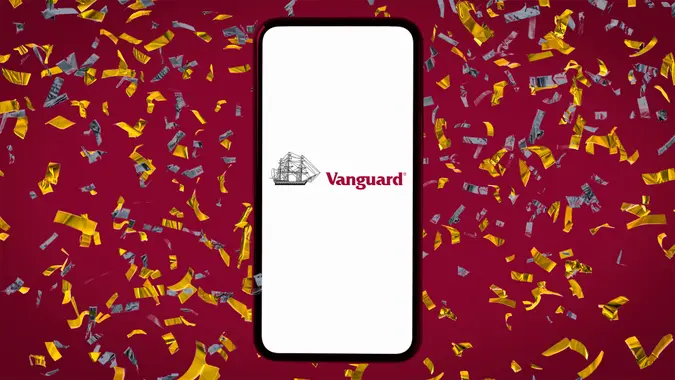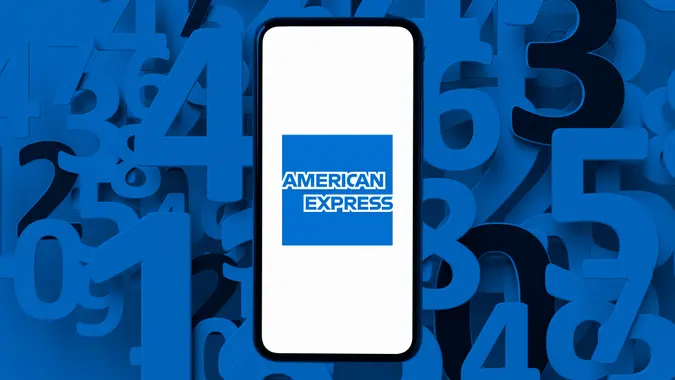What Is a CD Ladder? What You Need To Know

Commitment to Our Readers
GOBankingRates' editorial team is committed to bringing you unbiased reviews and information. We use data-driven methodologies to evaluate financial products and services - our reviews and ratings are not influenced by advertisers. You can read more about our editorial guidelines and our products and services review methodology.

20 Years
Helping You Live Richer

Reviewed
by Experts

Trusted by
Millions of Readers
Investing in a certificate of deposit might be right if you’re not the risky type, as it’s a safe way to grow your money — that is, if you’re willing to leave it in the bank until it matures.
If you’d like to earn more than a savings account, without restricting access to your money, a CD ladder could be a wise and low-risk way to do that. Setting one up is quite easy, too. Here’s how.
How Does a CD Ladder Work?
A CD ladder works by investing your money across several accounts that mature at different times. You’ll be able to access your money as it continues earning interest. When one of the CDs matures, you can choose to withdraw it or reinvest it into another CD to continue having regular access to your funds.
A CD ladder is a way to make the most of CDs and earn a higher overall return on your savings.
Benefits of CD Laddering
Generally, the safer the investment is, the lower its return will be. That’s why a CD ladder might be a great choice for a less risky investor. You can invest in intervals while tying up all of your funds into a single term. Here’s more on why CD ladders are effective.
Increased Ease of Access
The downside to CDs is that you do need to keep the CD in the account to avoid paying an early withdrawal penalty. The good news is that your investment is safe and FDIC-insured, so you don’t have to worry about losing your initial deposit.
Competitive Returns
That regular access to your money makes CD ladders a good alternative to high-yield savings accounts, which can earn similar annual percentage yields with fewer restrictions on withdrawals.
When your CD matures, there are two options to consider: withdraw the money or reinvest it into a new CD. If you need the cash right away, then withdrawing makes the most sense. If you choose to reinvest, you could benefit if the interest rate on the new CD is higher than before.
Every decision is personal and based on your own needs, so think about what you’d like to do with the money — use it or keep it growing in the CD ladder.
Flexibility
A CD ladder can boost your cash flow by strategically allocating certain amounts to CDs with different maturity dates. As time passes, you will earn interest on your CDs while the different maturity dates on your funds make your cash available in increments.
How To Build a CD Ladder
The basic principle behind building a CD ladder is the same, no matter how much you start with. Here are the steps to follow:
- Initial investment: Figure out how much you’d like to invest. This will be your initial principal.
- Select your banks: Narrow down the list of best banks and compare the rates.
- Add money to CD terms: Divide that amount evenly among several CD term lengths.
- When the CD matures: You can choose to automatically reinvest, withdraw or choose a different strategy when the CD matures.
CD Ladder Example for a $10K Investment
This example illustrates how to invest $10,000 in a five-year ladder:
- Open five CDs with $2,000 each and make sure the accounts’ ascending maturities are 12 months apart: 12 months, 24 months, 36 months, 48 months and 60 months, for example.
- When the 12-month CD matures, you can take out your money or renew it into a new five-year CD.
- A year later, when the 24-month CD matures, you have the same options.
- Continue this way until the 60-month CD matures.
If you renew each CD into a new five-year term, you’ll have a ladder of only five-year CDs after five years, each with different maturity dates. The benefit is, though, that despite the longer terms, you’ll still have access to your money once a year.
Your ladder doesn’t have to include five CDs or have maturities extending out five years. You can earn higher rates with shorter-term ladders that include just four CDs.
Fidelity provides model ladders to give investors ideas for building their own:
- One-year, four-CD ladder: Start with CDs that will mature in three, six, nine and 12 months. As each CD matures, renew each into a 12-month CD. After four years, they will all be 12-month CDs, but you’ll have access to the money once every three months.
- Two-year, four-CD ladder: Start with CDs that mature in six, 12, 18 and 24 months. As each CD matures, renew each into new 24-month CDs. After four years, they will all be 24-month CDs, but you can access the money every six months.
CD Laddering vs. Other Savings Strategies
A CD ladder is a good idea because it reduces the risk of the two downsides usually associated with CDs: the interest rate risk and low liquidity.
CD laddering offers several advantages that make the strategy appealing to investors. For example:
- CDs typically have higher rates of return than savings accounts.
- Not all of your money is invested at the same low rate if you ladder your CDs.
- CD laddering involves opening CDs of varying term lengths and renewing shorter-term CDs for longer-term CDs.
- You can set up some short-term CDs to gain more frequent access to your money in case you need cash in hand.
- If you invest during an economic slump, you can get higher interest rates as the economy improves.
However, CD ladders also have a couple of disadvantages to consider:
- You’ll have to keep track of maturity dates to keep maturing CDs from automatically renewing at the current rate.
- CDs’ low risk means the potential gains are also low compared to non-bank investments like stocks.
- If you open the bank accounts at a financial institution that has a high minimum deposit for new CDs, you could wind up putting money into CDs that would work better for you if invested elsewhere.
When it comes to building a CD ladder, keep it simple. Here are some tips that might help you build yours:
Have a Plan
Write down what you want to do with your savings and when you’ll need access to the money. Your access needs will determine how many CDs you invest in and how long their terms should be.
Stay Organized
Invest in your ladder CDs with the same bank. If they’re in one place and tied to one savings account, it will be easier to keep them organized.
Set Goals for Your Ladder
Choose maturities that are one, two or even five years out if you want to keep it simple. Any earlier maturity dates will require you to purchase a new CD every three to six months to keep your ladder in place. However, in the current rate environment, ladders with short terms might yield higher rates.
Who Should Use a CD Ladder?
If you’re the type who doesn’t like to take many risks, especially when it comes to money, you might be considered a conservative investor. CD ladders offer predictable returns, so you know exactly how much you can expect to earn once the CD matures.
Retirees might like CD ladders for similar reasons, as the returns are predictable, but you can also enjoy higher interest rates with longer terms and easy access to cash with shorter terms.
Finally, say you’re saving for a specific fund or an event such as a vacation or a wedding. You can set up a CD ladder, with all terms dedicated to the event, or perhaps a one-year term for vacation and a two-year term for the wedding, as examples.
Is CD Laddering Right for You?
With CD laddering, you can access some of your money periodically, which makes this a win-win financial strategy. This strategy helps in case interest rates ever fall or as a way to balance riskier investments in your portfolio. Lastly, having an account with one of the best CD rates can help you earn greater returns.
A checking account is flexible in how often you can add to your balance, but it usually earns low or no interest. A traditional savings account gives you more access, but you might also see low interest rates. Compared to those options, a CD is an excellent choice for anyone who wants good yields at little risk.
Taking full advantage of your CD investment options and laddering strategies will likely enhance your returns over time, so if you want to make your cash work harder for you, consider adding this technique to your financial playbook.
Explore More on CD Accounts
- Certificate of Deposit (CD): What It Is and Whether It’s Right for You
- How To Open a CD Account in 4 Simple Steps
- How Do CDs Work? Start Stacking Your Savings
- How Much Money Should You Keep in a CD Account?
- Pros and Cons of CD Accounts
- Best CD Accounts
FAQ
Here are the answers to some common questions about CDs and CD ladders.- What is a CD ladder, and how does it work?
- A CD ladder can boost your cash flow by strategically allocating certain amounts of money to CDs with different maturity dates. As time passes, you will earn interest on your CDs while the different maturity dates on your funds make your cash available in increments.
- Depending on your current cash flow situation, you can cash out a particular CD when it's available to spend, or you can roll it into another CD term to continue earning a set interest rate.
- How many CDs do you need to create a CD ladder?
- You can choose the number of CDs you'd like to include in your CD ladder based on your needs and cash available to deposit. If you're planning for an expense farther in the future, you could ladder five CDs, with the longest term at five years. Or, if you know you're going to need the cash sooner than that, you could open a ladder with three CDs, and have the longest term being three years, or less.
- You'll also want to consider how many CDs you have with minimum deposits. If you have $2,500 to invest, you could open five CDs with minimum deposits at $500 each, but if the bank you choose requires a $1,000 minimum deposit, you'd only have enough for two CDs in your ladder – at least to start.
- What happens when one CD in the ladder matures?
- When a CD in your ladder matures, you can choose to withdraw the money if you need it. You can invest it into a new term–for example, take the money from a one-year CD and move it into a five-year CD term. Or, you could reinvest it into the same term length or “auto-renew,” though you might be able to find better interest rates if the auto-renew option isn’t very competitive.
- Are there alternatives to CD laddering?
- Yes, you have several options besides CD laddering. You can try creating a bond ladder, which is very similar. You'll start by having funds set to mature at different times and rates. There’s always a high-yield savings account, as well, which can have generous APY rates. This is a good option if you need to have your cash always at the ready.
- How does CD laddering compare to other low-risk investments?
- CD laddering and having a CD, in general, is considered to be a secure investment because most are backed by either FDIC or NCUA insurance, which covers up to $250,000 per deposit account, per account holder. You have a fixed rate of return as well, so if you’re a conservative investor, you might like this guarantee once the CD matures.
Melanie Grafil, Daria Uhlig and Caitlyn Moorhead contributed to the reporting for this article.
Our in-house research team and on-site financial experts work together to create content that’s accurate, impartial, and up to date. We fact-check every single statistic, quote and fact using trusted primary resources to make sure the information we provide is correct. You can learn more about GOBankingRates’ processes and standards in our editorial policy.
- Discover. "CD Laddering: Make the Climb to Financial Success."
- Dollar Bank. "About CD laddering."
 Written by
Written by  Edited by
Edited by 

























